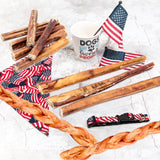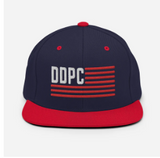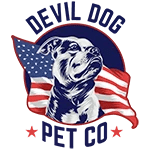Dog Diapers: The Ultimate Guide for Responsible Owners
Let's face it – sometimes our four-legged family members need extra help staying dry and clean. Whether you're dealing with a senior dog battling incontinence, a female in heat, or a pup with excitement urination, dog diapers can be a game-changer. But like any piece of tactical gear, the wrong fit or inferior materials can lead to mission failure – leaked floors, frustrated humans, and uncomfortable dogs. It's also important to know how often to change dog diaper to prevent leaks and ensure your dog stays comfortable and dry throughout the day.
When our dog Dexter hit his senior years, we found ourselves researching dog diapers after he started having occasional accidents. What seemed straightforward quickly turned into a complex operation with more options than an MRE menu. Disposable or washable? Male wraps or full coverage? The right fit could mean the difference between peaceful coexistence and constant cleanup.
As a Marine, I learned that preparation prevents poor performance. The same principle applies to managing your dog's diapering needs. This comprehensive guide will help you navigate the world of dog diapers with military precision, ensuring you select the right option for your mission parameters.
Understanding Dog Diapers: Not Just for Accidents
Dog diapers serve multiple tactical purposes beyond basic incontinence management. They're essential equipment for dogs experiencing age-related bladder weakness, females in heat, males with marking tendencies, post-surgical recovery, and even travel situations where bathroom breaks might be limited.
Unlike human diapers, dog diapers come in specialized designs that accommodate your dog's anatomy. Female dog diapers provide full coverage with a tail hole, while male dog diapers (often called belly bands) wrap around the waist to cover just the penis. Both styles serve the same fundamental purpose: containing moisture and preventing messes.
When Dog Diapers Become Mission-Critical
A customer recently shared how doggie diapers saved her sanity when her 14-year-old Labrador developed nighttime incontinence. Rather than relegating her loyal companion to outdoor living or considering euthanasia (options some vets unfortunately still suggest), she found that quality dog diapers allowed her senior friend to maintain his dignity and indoor privileges.
Beyond medical necessity, diapers for dogs can be tactical assets during:
- Female heat cycles (preventing spotting on furniture)
- House-training reinforcement (not replacement)
- Long car trips or flights
- Visits to other people's homes
- Recovery from spay/neuter procedures
Dog Diaper Types: Disposable vs. Reusable
Like choosing between MREs and home-cooked meals, the disposable versus reusable diaper decision involves tradeoffs in convenience, cost, and environmental impact. Let's break down your options with the clarity of a field manual.
Disposable Dog Diapers: The Quick-Deploy Option
Disposable dog diapers function like their human counterparts – use once and toss. They typically feature highly absorbent cores with leak-proof barriers and adhesive fasteners for secure fit.
The primary advantages include:
- Immediate readiness with no preparation
- Superior absorption technology (many use gel crystals that lock moisture away)
- Convenience during travel situations
- No washing required
- Often include wetness indicators
However, disposable options come with drawbacks:
- Higher long-term cost (approximately $0.50-$2.00 per diaper)
- Environmental impact from non-biodegradable materials
- Less customizable fit compared to fabric options
- Limited breathability that can lead to skin irritation
Washable Dog Diapers: The Sustainable Solution
Reusable dog diapers represent the more economical and environmentally responsible choice for ongoing needs. Made from durable, washable fabrics with waterproof outer layers, these doggie diapers for female dogs and males can withstand hundreds of wash cycles when properly maintained.
Key benefits include:
- Significant cost savings over time (typically $15-30 for a pack that lasts months)
- Reduced environmental footprint
- More breathable materials that reduce skin irritation
- Adjustable fasteners that provide a more customized fit
- Often more comfortable for extended wear
The tradeoffs are worth considering:
- Requires regular washing (typically every 1-2 days)
- Higher upfront investment
- May require additional absorbent inserts for heavy wetters
- Takes time to dry between uses (having 3-5 in rotation is recommended)
Learn more about the pros and cons of dog diapers in this Whole Dog Journal guide on dog diapers.
Hybrid Systems: The Best of Both Worlds
Many dog owners adopt a hybrid approach that would make any tactical planner proud. They use washable dog diapers as the base layer with disposable liners inserted for easy cleanup. This strategy maximizes absorption while minimizing environmental impact and cost.
A customer with a senior Chihuahua shared her system: "I use washable diapers female design with disposable pads inside. When she urinates, I just replace the pad rather than the whole diaper. It's saved me hundreds of dollars over the past year."
Sizing and Fit: The Most Critical Mission Parameter
The most effective diaper in the world fails if it doesn't fit properly. Unlike human diapers sized by weight, dog diapers require specific measurements:
Essential Measurements for Proper Fit
- Waist circumference: Measure around the narrowest part of your dog's waist, just in front of the hind legs
- Distance from waist to base of tail: Critical for female dog diapers
- Thigh circumference: Ensures leg holes won't chafe or allow leakage
Most manufacturers provide sizing charts, but they're not standardized across brands. What qualifies as "Medium" in one brand might be "Large" in another. Always check measurements rather than relying on size names or breed recommendations.
Male vs. Female Diaper Designs
The anatomical differences between male and female dogs necessitate different diaper designs:
- Male dog diapers (belly bands): Wrap around the waist and secure with fasteners, covering only the penis and not the anus
- Female dog diapers: Cover both urinary and anal openings with a tail hole, similar to a full diaper
Using the wrong type is a common mistake. A belly band on a female dog won't contain fecal matter or menstrual discharge. Similarly, a full diaper on a male dog who only marks provides unnecessary coverage that can cause overheating and discomfort.
Material Matters: What Makes a Quality Dog Diaper
In the Corps, we learned that gear quality can make or break a mission. The same applies to dog diapers. Premium materials deliver better performance and comfort.
Exterior Layer Requirements
The outer shell should be waterproof yet breathable. Look for:
- PUL (polyurethane laminate) fabric in washable diapers
- Moisture-barrier technology in disposables
- Stretchy, flexible materials that move with your dog
Avoid plastic-backed diapers that trap heat and cause skin irritation. Quality dog diapers balance waterproofing with air circulation.
Absorbent Core Construction
The heart of any dog diaper is its absorbent layer:
- Disposables often use super-absorbent polymers (SAP) that convert liquid to gel
- Reusable options typically feature microfiber, cotton, or hemp cores
- Premium dog diapers include multiple absorption layers with wicking action
When evaluating incontinence nappies for dogs, check absorption capacity ratings. Heavy wetters need industrial-strength cores that can handle multiple voids without leaking.
Fastening Systems That Actually Work
The best dog diaper in the world fails if it won't stay on. Effective fasteners include:
- Hook-and-loop (Velcro) closures with wide attachment zones
- Adjustable elastic for custom fitting
- Multiple attachment points for security
One customer's Labrador had mastered the art of diaper removal until she discovered dog diapers that stay on through a combination of properly positioned straps and a onesie overlay. Sometimes victory requires layered defenses.
Preventing Leaks: Tactical Approaches

Leakage is the primary enemy when deploying dog diapers. Combat this threat with proven strategies:
Strategic Placement and Adjustment
Position is critical:
- Center the absorbent core over urination points
- Ensure tail holes are properly sized and positioned
- Check for gaps around leg openings
- Adjust waistbands to be snug but not tight (you should be able to slip two fingers between the diaper and your dog's skin)
For male dog diapers for pee, position the absorbent pad to catch forward spray. Female dog incontinence pants require centered placement with adequate rear coverage.
Frequency of Changes
Even the best dog diapers require regular changes to prevent leaks and skin issues:
- Check every 2-4 hours during waking hours
- Change immediately after bowel movements
- Use overnight-specific diapers with extra absorption for extended wear
Setting a timer helps establish a routine that prevents overflow incidents. Remember: a wet diaper can only hold so much before physics takes over.
Supplemental Protection Strategies
Create defense in depth with these tactical additions:
- Diaper liners for added absorption
- Waterproof covers over washable diapers
- Dog diaper suspenders for escape artists
- Bodysuit overlays that prevent shifting
When our dog Dexter became adept at removing his diaper, we employed a modified t-shirt as a secondary containment system. Adaptation and improvisation are essential skills for the serious dog handler.
For additional incontinence tips and care strategies, visit Husky Haven's incontinence tips.
Comfort and Acceptance: Getting Your Dog On Board
The success of any dog diaper deployment hinges on your dog's willingness to wear it. Like training recruits for a new mission, introducing dog diapers requires patience, positive reinforcement, and proper technique.
Gradual Introduction Protocol
Dogs rarely accept diapers immediately. Follow this progressive approach:
- Begin with short wearing periods (5-10 minutes) several times daily
- Pair diaper wearing with high-value treats and positive attention
- Gradually extend wearing time as acceptance improves
- Maintain normal activity levels during introduction periods
One customer's senior Great Dane initially resisted doggie diapers for incontinence but accepted them after a week of consistent, positive introduction. Persistence pays dividends when establishing new routines.
Monitoring for Discomfort Signals
Watch for signs that adjustments are needed:
- Excessive licking or chewing at the diaper
- Reluctance to move or unusual gait
- Redness, chafing, or irritation at contact points
- Attempts to remove the diaper
Address issues immediately—discomfort leads to resistance. When our dog Dexter showed signs of chafing around his legs, switching to a different brand with softer elastic resolved the issue within days.
Creating Positive Associations
Transform diaper time into a positive experience:
- Use the same cheerful voice commands each time ("Diaper time!")
- Reward cooperation with treats and praise
- Incorporate favorite activities immediately after diapering
- Never punish or express frustration during the process
The psychological component is as important as the physical fit. Dogs that associate diapers with positive outcomes accept them far more readily than those who connect them with stress or discomfort.
Skin Health: Preventing the Hidden Enemy
Extended diaper use creates a microenvironment that can compromise skin integrity. Proactive maintenance prevents problems that could derail your entire diaper strategy.
Inspection and Cleaning Routine
Establish a regular maintenance schedule:
- Check skin condition during every diaper change
- Clean the diaper area with gentle, unscented wipes
- Allow skin to dry completely before applying a new diaper
- Schedule regular "air time" with no diaper (supervised)
This preventative approach mirrors military maintenance protocols—regular inspection prevents catastrophic failure. One customer's Chihuahua developed a rash that quickly resolved once they implemented a twice-daily cleaning routine.
Moisture Management Strategies
Combat the primary threat—moisture trapped against skin:
- Use moisture-wicking liners that pull wetness away from skin
- Apply corn starch (never talcum powder) to absorb dampness
- Consider washable dog diapers female design with breathable zones
- Change diapers more frequently for heavy wetters
The battle against moisture requires vigilance and appropriate tools. Quality materials that maintain airflow while controlling wetness provide the tactical advantage.
Treating and Preventing Irritation
When irritation appears, respond decisively:
- Apply veterinarian-approved barrier creams (zinc oxide-based products work well)
- Increase diaper-free time until improvement occurs
- Switch to hypoallergenic materials if recurring issues persist
- Consult your veterinarian for persistent or severe irritation
Prevention trumps treatment. Establishing proper rotation of dog diapers that stay on without excessive tightness will minimize skin complications from the start.
Special Situations: Adapting Your Approach
Different scenarios demand tailored diaper strategies. Like mission-specific gear, your approach should adapt to the situation at hand.
Heat Cycles and Female Dogs
Managing a female dog in heat requires specialized tactics:
- Use female dog diapers/large enough to accommodate discharge volume
- Change more frequently (every 3-4 hours minimum)
- Consider disposable options for heaviest days
- Use dark-colored washable dog diapers female design to hide staining
A customer with a German Shepherd found that rotating between three sets of washable doggie diapers for females with disposable liners provided the best management during heat cycles, allowing normal activity while preventing household mess.
For more insights into whether dog nappies are a good idea, see this informative article from Dundies.
Overnight Protection Systems
Nighttime presents unique challenges:
- Use maximum-absorption overnight-specific products
- Layer diaper liners for added protection
- Consider waterproof bedding as a secondary defense
- Position the diaper slightly higher on the back for sleeping postures
For senior dog diapers used overnight, capacity trumps all other considerations. One extra layer of protection can mean the difference between uninterrupted sleep and middle-of-the-night cleanup operations.
Travel and Public Outings
Mobility requires modified protocols:
- Pack extra diapers (more than you think you'll need)
- Bring disposal bags for used products
- Consider disposable options for convenience
- Use a protective harness that helps secure the diaper during activity
When traveling with incontinent dogs, redundancy is your ally. Having multiple options—like both cloth dog diapers and disposable backups—ensures you're prepared for any situation.
The Bottom Line: Committing to Success
Effective dog diaper use requires the same commitment to excellence we valued in the Corps. Half-measures produce half-results. Whether managing incontinence nappies for dogs or puppy diapers male or female, your consistent leadership determines the outcome.
Success hinges on several core principles:
- Proper sizing and fit—the foundation of leak prevention
- Quality materials appropriate to your specific situation
- Consistent maintenance routines that prevent complications
- Positive training approaches that gain your dog's cooperation
- Adaptability when facing changing needs or challenges
Remember that dog diapers represent a tool, not a complete solution. They work best as part of a comprehensive management strategy that includes appropriate veterinary care, regular exercise, and attention to your dog's overall wellbeing.
The investment of time in finding the right products pays dividends in reduced cleaning, improved hygiene, and better quality of life for both you and your dog. Whether you're managing a senior with incontinence, a female in heat, or a dog recovering from surgery, the right diaper system creates freedom and confidence.
At Devil Dog Pet Co., we understand that the bond between handler and dog depends on mutual trust and commitment. Proper management of health challenges strengthens rather than weakens that relationship. By taking ownership of the situation and implementing effective solutions, you demonstrate the leadership your dog naturally respects.
The path to diaper success isn't always straight or simple. You may need to experiment with different products, adjust your approach, and remain flexible as your dog's needs evolve. That's the nature of the mission—adaptation, persistence, and unwavering commitment to your dog's welfare.
In the end, the effort invested in proper diaper management pays off in extended time together, reduced stress, and maintained dignity for your faithful companion. That's an objective worth achieving with all the determination and attention to detail you'd bring to any important mission.
Because when it comes to caring for the dogs who give us their absolute loyalty, nothing less than excellence will do.
To further improve your dog care strategy, check out our expert advice on how to trim your dog's nails quickly and safely. For those with black-nailed pups, our expert guide to cutting black dog nails will boost your confidence. If you're planning an adventure, don't miss our camping with your dog tips for safe travels. Selecting the right chews is also key for lasting health—read our guide to safe and properly sized dog chews for more.
Understanding your dog's body language is vital for any owner; discover what dog side eye really means. For new pup parents, our first-time pup owner tips offer actionable guidance. Avoid common pitfalls by reading about mistakes new dog owners make. Lastly, stay proactive by learning about common dog health issues and prevention for a healthier pup.
Recommended Chew Collections for Your Dog
Complement your dog care routine with our premium selection of chews designed to suit dogs of all sizes and preferences. Check out our top picks:
- Premium Elk Antler Dog Chews – Durable and natural for long-lasting enjoyment.
- Small Dog Chews Collection – Perfectly sized treats for smaller breeds.
- Large Dog Chews Collection – Robust options to satisfy bigger appetites.
Download the FREE 10-Step Dog Prep Guide
Frequently Asked Questions
Are doggie diapers a good idea?
Doggie diapers can be a great solution for managing incontinence, heat cycles, or marking behavior in dogs. They help keep your home clean and reduce stress for both pets and owners. However, it's important to use them correctly and ensure your dog is comfortable to avoid skin irritation or discomfort.
What is an alternative to diapers for dogs?
Alternatives to dog diapers include belly bands for male dogs, frequent outdoor bathroom breaks, and training to improve bladder control. Additionally, some pet owners use waterproof bedding or washable pads to manage accidents. Consulting a vet for underlying health issues can also provide long-term solutions.
What are the disadvantages of dog diapers?
Dog diapers can cause skin irritation, rashes, and infections if left on for too long or if not changed frequently. They may also restrict movement or make some dogs feel uncomfortable or anxious. Plus, improper sizing can lead to leaks or chafing, so it's crucial to choose the right fit.
How long can a dog wear a dog diaper?
Dogs should not wear diapers continuously for more than 4 to 6 hours at a time to prevent skin problems and discomfort. It's best to change the diaper as soon as it becomes soiled and allow the skin to breathe between uses. Overnight use is possible but requires careful monitoring and frequent changes.
Should dogs wear diapers yes or no?
Whether a dog should wear diapers depends on their individual needs, such as health issues or behavioral reasons. In many cases, diapers are a helpful tool for managing specific situations, but they are not a long-term solution. Consulting with a veterinarian can help determine if diapers are appropriate for your dog.
Can dogs pee in doggy diapers?
Yes, dogs can pee in doggy diapers, as these products are designed to absorb urine and keep your dog dry. However, not all dogs will immediately accept wearing diapers, so some training and positive reinforcement may be needed. Proper fit and frequent changing are key to preventing leaks and discomfort.






